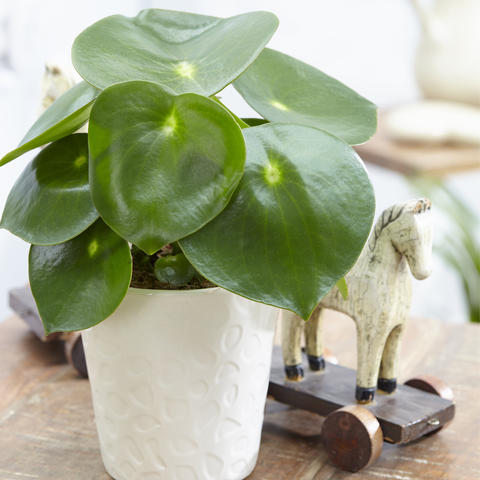Baby Rubber Plant, Pepper face
The Peperomia, also known as Pepper face, is captivating all year round with fresh green leaves — if you are able to meet its care demands. Here, you will find planting tips and how to select the right planting location.
Factsheet
- Growth type
-
- Perennial plant
- Growth height (from)
- from 15 cm to 30 cm
- Growth characteristics
-
- horst-forming
- Flower color
-
- yellow
- white
- Flowering time (month)
-
- April to December
- Flower shape
-
- Spike
- small
- Pistons
- unimpressive
- Flower characteristics
-
- unimpressive
- Leaf color
-
- green
- multicolored
- page format
-
- elliptiques
- full margined
- inverted egg shape
- Sheet properties
-
- evergreen
- Fruit shape
-
- Berry
- Fruit characteristics
-
- unimpressive
- Light
-
- scattered light to semi-shade
- Soil type
-
- stony to gravelly
- Soil Moisture
-
- moderately humid to humid
- Lime compatibility
-
- lime-tolerant
- Nutrient requirements
-
- nutrient-rich
- Humus
-
- rich in humus
- Decorative or utility value
-
- Leaf ornaments
- picturesque growth
- Use
-
- Interior greening
- Winter garden
- Warm House
The Baby Rubber Plant (Peperomia obtusifolia) is a popular evergreen houseplant that gives a fresh green splash of color, within the four walls of your home, all year round. The plant, also called Pepper face, is botanically classified as one of the pepper plants (Piperaceae) and is native to the tropical and subtropical regions of Central and South America. Hence the special care requirements of Peperomia: It likes warmth all year round.
The Peperomia is a shrub with compact growth. It forms a dense thicket and reaches heights of between 5.90 and 11.81 inches. Its ornamental foliage varies depending on the type, variety and breed and ranges from pure green to variegated yellow-green.
The leaves of the Baby Rubber Plant are 1.96 to 3.24 inches long, slightly fleshy, and leathery to the touch. Their shape is obovate to elliptical. All leaves, whether variegated or monochrome, have a shiny leaf blade.
The flowering period of Peperomia lasts from April to December. However, the bulb-shaped flowers, found in the spikes, are very small and inconspicuous and almost disappear between the pretty leaves with their pale green to yellowish-white color.
The seed heads of the peperomia are made of small and inconspicuous berries.

The planting location is crucial for the Peperomia to thrive. Place the plant in a bright and shaded spot. The more colorful the leaves, the more light the Pepper face needs. However, direct sunlight should always be avoided. Also, ensure that the Peperomia is protected from drafts and that it is warm all year round. The ornamental foliage plant does not like temperature fluctuations at all, a constant room temperature of around 68 degrees Fahrenheit is perfect. It shouldn't get colder than 64.4 degrees Fahrenheit in winter either.
The Baby Rubber Plant can be grown both in hydroponics and in commercial potting soil. With potting soil, it is advisable to fill a drainage layer made of expanded clay or gravel at the bottom of the planter.
the substrate of Peperomia is ideally always slightly damp, but never wet. Finding the right balance is the greatest challenge faced by the houseplant owner for a plant that is very robust and easy to care for. Always check if water has collected in the planter or coaster and remove it immediately.
The Baby Rubber Plant is fertilized all year round by adding low doses of fertilizer in the water. Every two weeks from spring to fall, every four weeks in winter. You can use conventional liquid fertilizer for indoor plants for this.
Repotting is done usually once a year for the Peperomia. The best time for this is in spring or in summer. Since the plant does not develop pronounced roots, the pot should not be too big - one size bigger is usually sufficient. Incidentally, the Peperomia looks attractive in a bowl or a hanging basket. In case of older, fully grown specimens, it is sufficient to replace the top layer of soil.
Pruning is not required. If Peperomia has wilted or dry leaves, these can simply be plucked out and removed by hand.

Several varieties of Peperomia obtusifolia are commercially available, which have the same properties as the species and only differ in the color of their foliage. “USA”, for example, has yellow-green leaves, “Variegata” is characterized by variegated leaves in green and light yellow. The “Green”’and “Raindrop” varieties are both single-colored and fresh green.
In spring or summer, Pepper face can be propagated by cuttings from head or leaf cuttings. It takes about six weeks for them to root firmly.
The typical pests that frequently infest indoor plants, do not spare the peperomia either. Therefore, keep checking for spider mites and mealybugs. Waterlogging can lead to root, stem and leaf rot. Occasionally, red spider infestation can occur.

